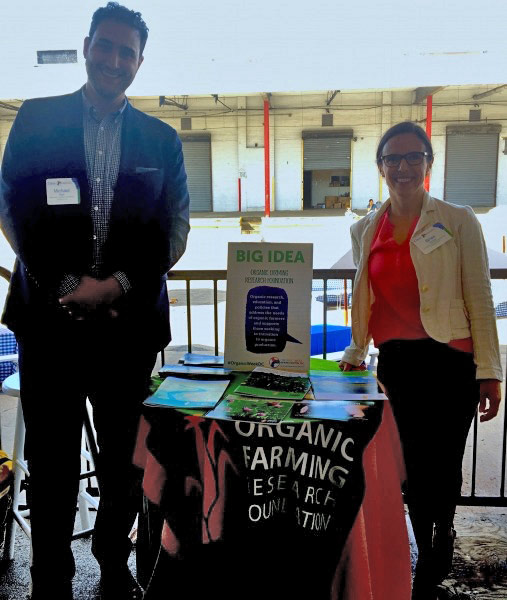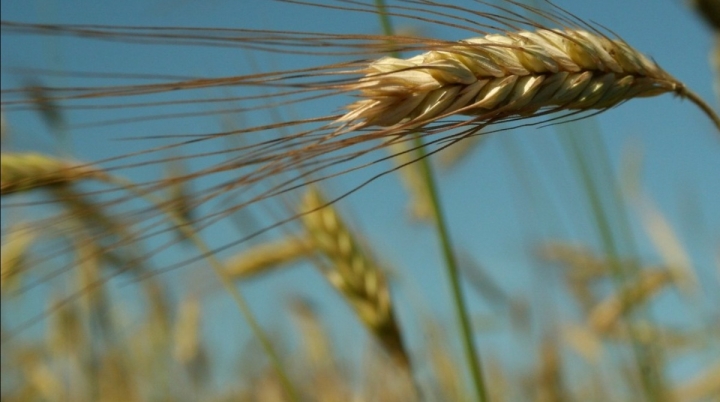March 12, 2019 – By Lauren Snyder, Research & Education Associate, OFRF

March 12, 2019 – As I was eating my breakfast this morning, I looked out the window and caught a glimpse of a bobcat passing through our field. It was such an incredible way to start the day; feeling inspired by nature and grateful to live in such a beautiful environment. However, my cheery mood quickly evaporated when I got to the office and skimmed the latest headlines. These days, it seems every time we open our devices, we are confronted with another bleak article explaining that “we’re going to hell in a handbasket,” as one of my mentors likes to put it.
For example, many of us have heard that there will likely be more plastic than fish in the oceans by 2050, and we are already experiencing the devastating effects of anthropogenic climate change in the form of more frequent and severe fires, floods, droughts, and storms. Now, add to that depressing list the alarming news from a recent scientific review revealing dramatic losses in insect biodiversity that could lead to the extinction of 40% of the world’s insect species over the next few decades (Sánchez-Bayo & Wyckhuys, 2019). With this news, you may be tempted to throw up your hands in frustration and walk away, but I encourage you to read on because this is an issue you have the power to tackle—just by eating. Let me explain.
The Problem
We are living through the sixth major extinction—species around the globe are disappearing at never-before-seen rates. While most attention is focused on vertebrate species loss, such as mammals and birds, a recent article in the journal of Biological Conservation indicates that the local extinction rate of insect species is eight times higher than that of vertebrates. That is something we should all be very concerned about. As the authors of the study explain, “because insects constitute the world’s most abundant and speciose animal group and provide critical services within ecosystems, such an event cannot be ignored and should prompt decisive action to avert a catastrophic collapse of nature’s ecosystems.”
 Insects may be more discrete than their charismatic vertebrate counterparts, but the ramifications of their dramatic decline will be anything but inconspicuous. Individually unassuming, insects comprise roughly one gigaton of biomass carbon on Earth (Bar-on et al., 2018) and support a number of valuable services that we rely on every day, such as pollination, pest control, and nutrient cycling (Aizen et al., 2009). Insects also play an essential role as food resources for many vertebrates, including moles, lizards, birds, bats, and fish.
Insects may be more discrete than their charismatic vertebrate counterparts, but the ramifications of their dramatic decline will be anything but inconspicuous. Individually unassuming, insects comprise roughly one gigaton of biomass carbon on Earth (Bar-on et al., 2018) and support a number of valuable services that we rely on every day, such as pollination, pest control, and nutrient cycling (Aizen et al., 2009). Insects also play an essential role as food resources for many vertebrates, including moles, lizards, birds, bats, and fish.
The new study documents a reduction in a large number of insect species concurrent with an increase in a small number of adaptable (often non-native) species that are filling vacated niches. The overall result is that insect communities are, in general, becoming more uniform and less diverse. This shift will have major repercussions for the ecosystem services provided by insects.
The mass decline we are witnessing in insects is particularly concerning because it includes not only specialist species, which rely on a specific habitat or resource and are therefore more susceptible to subtle shifts in the environment, but also generalist species, which we would expect to be more resilient to external stressors because they tend to be more flexible in terms of their food and/or living preferences. The fact that we see a decline in both specialist and generalist insects suggests the causes of the decline are not isolated to specific habitats or traits, but are more broad-reaching and affect traits shared among all insects.
The Causes
So what underlies this broad decline in insect diversity and abundance? While there are several causes, the biggest culprit appears to be agriculture; or more specifically, intensive agricultural practices that rely on the use of synthetic fertilizers and pesticides. “The intensification of agriculture over the past six decades stands as the root cause of the problem, and within it the widespread, relentless use of synthetic pesticides is a major driver of insect losses in recent times (Dudley & Alexander, 2017),” says the review.
Habitat loss and pollution are the biggest drivers of insect declines and both are associated with modern day agriculture. As the review describes, in the first half of the 20thcentury, the conversion of forests, wetlands, grasslands, and other natural habitats to agriculture in North America and Europe negatively affected overall biodiversity. Today, roughly 40% of terrestrial surfaces are dedicated to agricultural uses (FAO 2009). These land use changes negatively affected insect communities, but we began to see even larger insect declines during the Green Revolution when traditional, low-input farming practices were largely replaced by industrial practices heavily reliant on synthetic inputs to control pests and support crop yields. While the changes associated with the Green Revolution did not necessarily involve further loss of natural habitats, the widespread implementation of monocultures led to a significant reduction in insect biodiversity—creating prime conditions for agricultural pests to flourish. According to the review’s authors, “the conclusion is clear: unless we change our ways of producing food, insects as a whole will go down the path of extinction in a few decades.”
How We Can Solve It
Ironically, while agriculture has been identified as one of the main drivers of the major insect decline, it also has potential to be the solution. The solution, say the authors of the review, requires “a rethinking of current agricultural practices, in particular a serious reduction in pesticide usage and its substitution with more sustainable, ecologically-based practices.”
 Organic agriculture has the potential to provide this solution, as it prohibits the use of synthetic fertilizers and pesticides, and therefore reduces environmental pollution associated with the reduced abundance and diversity of insects. A recent publication in Nature demonstrated that organic farming systems enhanced pest control services compared to conventional systems and that implementation of organic practices can reduce the use of synthetic pesticides (Muneret et al. 2018). Moreover, best management of organic systems involves implementing practices such as wildflower strips, hedgerows, and diversified crop rotations, which have been shown to enhance the abundance of wild insect species (Kremen & Merenlender, 2018).
Organic agriculture has the potential to provide this solution, as it prohibits the use of synthetic fertilizers and pesticides, and therefore reduces environmental pollution associated with the reduced abundance and diversity of insects. A recent publication in Nature demonstrated that organic farming systems enhanced pest control services compared to conventional systems and that implementation of organic practices can reduce the use of synthetic pesticides (Muneret et al. 2018). Moreover, best management of organic systems involves implementing practices such as wildflower strips, hedgerows, and diversified crop rotations, which have been shown to enhance the abundance of wild insect species (Kremen & Merenlender, 2018).
This is where you, the reader, come into the story because you have the power to change the way we grow our food. Remember how I said you can tackle this issue just by eating? Well, by electing to eat organically produced food, you are sending a message that you care about where your food comes from and the impact its production has on the environment and its inhabitants. Eating organic supports farmers who implement practices that promote biodiversity and good stewardship of the land.
It can be debilitating to confront the myriad of seemingly apocalyptic environmental issues our society is facing, but there are straightforward decisions you can make today to resolve these issues. And, it all starts with what you’re putting on your plate.
References:
Aizen, M. A., Garibaldi, L. A., Cunningham, S. A., Klein, A. M. 2009. How much does agriculture depend on pollinators? Lessons from long-term trends in crop production. Ann. Bot. 103: 1579-1588.
Bar-On, Y. M., Phillips, R., Milo, R. 2018. The biomass distribution on Earth. PNAS. 115 (25): 6506-6511.
Dudley, N., Attwood, S. J., Goulson, D., Jarvis, D., Bharucha, Z. P., Pretty, J. 2017. How should conservationists respond to pesticides as a driver of biodiversity loss in agroecosystems? Bio. Conserv. 209: 449-453.
FAO 2009. Statistics from www.faostat.fao.org, Rome, Italy: FAO
Kremen, C., and A. M. Merenlender. 2018. Landscapes that work for biodiversity and people. Science. 362.
May, R. M., 2010. Ecological science and tomorrow’s world. Philos. Trans. R. Soc. Lond. B Biol. Sci. 365: 41-47.
Muneret, L., Mitchell, M., Seufert, V., Aviron, S. Djoudi, E. A., Pétillon, J., Plantegenest, M., Thiéry, D., Rusch, A. 2018. Evidence that organic farming promotes pest control. Nature. 1: 361-368.
Sánchez-Bayo, F., and K. A. G.Wyckhuys. 2019. Worldwide decline of the entomofauna: A review of its drivers. Biological Conservation. 232: 8-27.




 May 21, 2019 – OFRF has awarded a grant to Aysha Peterson at UC Santa Cruz to examine barriers to adoption of plant-based nutrient management strategies among organic, socially disadvantaged farmers in Salinas, California. Peterson hopes to bridge the gap between research and implementation by using qualitative data to answer questions about adoption and decision-making processes.
May 21, 2019 – OFRF has awarded a grant to Aysha Peterson at UC Santa Cruz to examine barriers to adoption of plant-based nutrient management strategies among organic, socially disadvantaged farmers in Salinas, California. Peterson hopes to bridge the gap between research and implementation by using qualitative data to answer questions about adoption and decision-making processes.




 May 5, 2019 – Proceedings from the 2019 Organic Agriculture Research Forum are now available. This day-long event held on February 16th in Portland Oregon, featured innovative presentations from researchers across all disciplines related to organic farming and food systems.
May 5, 2019 – Proceedings from the 2019 Organic Agriculture Research Forum are now available. This day-long event held on February 16th in Portland Oregon, featured innovative presentations from researchers across all disciplines related to organic farming and food systems. April 29, 2019 – Development, testing, and release of resistant varieties is essential to controlling downy mildew and bacterial wilt, diseases that pose a significant and costly production challenge for organic farmers. OFRF is pleased to announce a second-year research grant to Edmund Frost of Common Wealth Seed Growers to continue his assessment of downy mildew resistant cucumber seedstocks. Frost will focus on evaluating and advancing cucumber seedstock lines that performed well in his 2018 trials.
April 29, 2019 – Development, testing, and release of resistant varieties is essential to controlling downy mildew and bacterial wilt, diseases that pose a significant and costly production challenge for organic farmers. OFRF is pleased to announce a second-year research grant to Edmund Frost of Common Wealth Seed Growers to continue his assessment of downy mildew resistant cucumber seedstocks. Frost will focus on evaluating and advancing cucumber seedstock lines that performed well in his 2018 trials.


 April 16, 2019 – OFRF announced the first of five grants the organization will award this year focused on the most pressing challenges facing organic farmers and ranchers today. The grant is funded in part by a match from the Foundation for Food and Agriculture Research (FFAR) aimed at funding research related to improving soil health and reducing the environmental impacts of agriculture.
April 16, 2019 – OFRF announced the first of five grants the organization will award this year focused on the most pressing challenges facing organic farmers and ranchers today. The grant is funded in part by a match from the Foundation for Food and Agriculture Research (FFAR) aimed at funding research related to improving soil health and reducing the environmental impacts of agriculture.
 I came to the Organic Agriculture Research Forum in Portland wearing two different hats, farmer and researcher. My family and I own a diverse, 40-acre farm in the Cowichan Valley on Vancouver Island, British Columbia, and I teach and carry out on-farm field trials, focused on soil health assessment, with the Faculty of Land and Food Systems at the University of British Columbia (UBC), in Canada. My goal was to hear from and connect with other organic systems researchers, farmers, and farm systems suppliers, and the research forum and trade show gave me all that and more! Over the delicious breakfast, a former co-worker from the UBC Farm found me, and we enjoyed a good catch-up session on family and farming. Grafting has been an interest for both of our farming operations since 2014, and the first Research Forum session was an outstanding, fast-paced overview of practical progress on that front. As an on-farm researcher, improving outreach efforts and field research design are ongoing areas of focus, and the lively Q&A sessions following each talk provided useful synthesis and additional connections for each of those key points. Break times and lunch were great opportunities to enjoy the bounty of the Pacific Northwest growing region, and to connect with growers and trade show vendors. With plastic bag bans and the food systems waste stream challenge at the forefront of the conversation in many of our Vancouver Island cities, I especially appreciated the award- winning packaging display of A&A produce. Also, during the break, I re-connected with Diane Nichols, of the UC Santa Cruz Farm & Garden Project. My organic farming life began in Santa Cruz, farming under the mentorship of a former Apprentice leader, Dennis Tamura. The deep and wide roots of the organic farming, research and teaching communities that reach up the west coast and into British Columbia were well represented at this Forum, and I am deeply appreciative for the opportunities to be present and recharge.
I came to the Organic Agriculture Research Forum in Portland wearing two different hats, farmer and researcher. My family and I own a diverse, 40-acre farm in the Cowichan Valley on Vancouver Island, British Columbia, and I teach and carry out on-farm field trials, focused on soil health assessment, with the Faculty of Land and Food Systems at the University of British Columbia (UBC), in Canada. My goal was to hear from and connect with other organic systems researchers, farmers, and farm systems suppliers, and the research forum and trade show gave me all that and more! Over the delicious breakfast, a former co-worker from the UBC Farm found me, and we enjoyed a good catch-up session on family and farming. Grafting has been an interest for both of our farming operations since 2014, and the first Research Forum session was an outstanding, fast-paced overview of practical progress on that front. As an on-farm researcher, improving outreach efforts and field research design are ongoing areas of focus, and the lively Q&A sessions following each talk provided useful synthesis and additional connections for each of those key points. Break times and lunch were great opportunities to enjoy the bounty of the Pacific Northwest growing region, and to connect with growers and trade show vendors. With plastic bag bans and the food systems waste stream challenge at the forefront of the conversation in many of our Vancouver Island cities, I especially appreciated the award- winning packaging display of A&A produce. Also, during the break, I re-connected with Diane Nichols, of the UC Santa Cruz Farm & Garden Project. My organic farming life began in Santa Cruz, farming under the mentorship of a former Apprentice leader, Dennis Tamura. The deep and wide roots of the organic farming, research and teaching communities that reach up the west coast and into British Columbia were well represented at this Forum, and I am deeply appreciative for the opportunities to be present and recharge. As a graduating senior and soon-to-be graduate student, this was my first time attending the forum. I was pleasantly surprised by the diversity in oral presentation and poster topics, ranging from crop insurance, to pest management, and whether or not organic farmers were ready for new food safety regulations. At the same time, throughout the day I started to see connections between the array of topics, and the projects my own research team works on. One presentation that we all found intriguing was Amanda Marabesi’s talk, entitled, “A phenomenological inquiry into producers’ experiences growing organic produce.” As part of the social science segment, this presentation centered on a survey of growers and extension agents, regarding their experience with organic agriculture in Georgia. Our team has conducted a number of surveys, and I am currently in the midst of conducting interviews with olive growers in Oregon. Despite the different regions and questions our surveys focused on, I found it enlightening to see how Marabesi presented her findings, and how she used the data to tell a larger story about the organic industry in Georgia.
As a graduating senior and soon-to-be graduate student, this was my first time attending the forum. I was pleasantly surprised by the diversity in oral presentation and poster topics, ranging from crop insurance, to pest management, and whether or not organic farmers were ready for new food safety regulations. At the same time, throughout the day I started to see connections between the array of topics, and the projects my own research team works on. One presentation that we all found intriguing was Amanda Marabesi’s talk, entitled, “A phenomenological inquiry into producers’ experiences growing organic produce.” As part of the social science segment, this presentation centered on a survey of growers and extension agents, regarding their experience with organic agriculture in Georgia. Our team has conducted a number of surveys, and I am currently in the midst of conducting interviews with olive growers in Oregon. Despite the different regions and questions our surveys focused on, I found it enlightening to see how Marabesi presented her findings, and how she used the data to tell a larger story about the organic industry in Georgia. March 22, 2019 – Recordings from the 2019 Organic Agriculture Research Forum held in February are now posted. There are 15 sessions covering a wide range of topics available to view.
March 22, 2019 – Recordings from the 2019 Organic Agriculture Research Forum held in February are now posted. There are 15 sessions covering a wide range of topics available to view. 
 Insects may be more discrete than their charismatic vertebrate counterparts, but the ramifications of their dramatic decline will be anything but inconspicuous. Individually unassuming, insects comprise roughly one gigaton of biomass carbon on Earth (Bar-on et al., 2018) and support a number of valuable services that we rely on every day, such as pollination, pest control, and nutrient cycling (Aizen et al., 2009). Insects also play an essential role as food resources for many vertebrates, including moles, lizards, birds, bats, and fish.
Insects may be more discrete than their charismatic vertebrate counterparts, but the ramifications of their dramatic decline will be anything but inconspicuous. Individually unassuming, insects comprise roughly one gigaton of biomass carbon on Earth (Bar-on et al., 2018) and support a number of valuable services that we rely on every day, such as pollination, pest control, and nutrient cycling (Aizen et al., 2009). Insects also play an essential role as food resources for many vertebrates, including moles, lizards, birds, bats, and fish. Organic agriculture has the potential to provide this solution, as it prohibits the use of synthetic fertilizers and pesticides, and therefore reduces environmental pollution associated with the reduced abundance and diversity of insects. A recent publication in Nature demonstrated that organic farming systems enhanced pest control services compared to conventional systems and that implementation of organic practices can reduce the use of synthetic pesticides (Muneret et al. 2018). Moreover, best management of organic systems involves implementing practices such as wildflower strips, hedgerows, and diversified crop rotations, which have been shown to enhance the abundance of wild insect species (Kremen & Merenlender, 2018).
Organic agriculture has the potential to provide this solution, as it prohibits the use of synthetic fertilizers and pesticides, and therefore reduces environmental pollution associated with the reduced abundance and diversity of insects. A recent publication in Nature demonstrated that organic farming systems enhanced pest control services compared to conventional systems and that implementation of organic practices can reduce the use of synthetic pesticides (Muneret et al. 2018). Moreover, best management of organic systems involves implementing practices such as wildflower strips, hedgerows, and diversified crop rotations, which have been shown to enhance the abundance of wild insect species (Kremen & Merenlender, 2018).